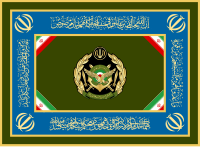
Back جيش الجمهورية الإسلامية الإيرانية Arabic ایران ایسلام جومهوریتینین قوشونو AZB سوپای کۆماری ئیسلامیی ئێران CKB Íránská armáda Czech Ejército de la República Islámica de Irán Spanish ارتش جمهوری اسلامی ایران Persian Armée de la république islamique d'Iran French צבא איראן HE Esercito della Repubblica Islamica dell'Iran Italian イラン・イスラム共和国軍 Japanese
| Islamic Republic of Iran Army | |
|---|---|
| ارتش جمهوری اسلامی ایران
ARTEŠ-E JOMHURIY-E ESLĀMI-E IRĀN | |
 Seal of the Islamic Republic of Iran Army | |
Flags of the Islamic Republic of Iran Army | |
| Motto | |
| Founded |
|
| Current form | 1979 (Islamic Republic) |
| Service branches |
|
| Headquarters | Khatam-al Anbiya Central Headquarters, Tehran |
| Website | aja |
| Leadership | |
| Commander-in-Chief | Maj. Gen. Abdolrahim Mousavi |
| Deputy Commander-in-Chief | Brig. Gen. Mohammad-Hossein Dadras |
| Personnel | |
| Military age | 18[6] |
| Conscription | 21 months |
| Active personnel | 420,000[7]
|
| Expenditure | |
| Budget | $18.4 billion (2024)[8] |
| Related articles | |
| History | |
| Ranks | Rank insignia of the Iranian military |
The Islamic Republic of Iran Army[9] (Persian: ارتش جمهوری اسلامی ایران), acronymed AJA (Persian: آجا), simply known as the Iranian Army or the Artesh (Persian: ارتش, romanized: Arteš,(Ərtēš)), is the conventional military of Iran and part of the Islamic Republic of Iran Armed Forces.[10] It is tasked to protect the territorial integrity of the country from external and internal threats and to project power.[10]
The Artesh has its own Joint Staff[11] which coordinates its four separate service branches: the Islamic Republic of Iran Army Ground Forces, the Islamic Republic of Iran Air Force, the Islamic Republic of Iran Navy and the Islamic Republic of Iran Air Defense Force.[10]
- ^ Shahbazi, A. Sh. (August 12, 2011) [December 15, 1986]. "ARMY i. Pre-Islamic Iran". In Yarshater, Ehsan (ed.). Encyclopædia Iranica. 5. Vol. II. New York: Bibliotheca Persica Press. pp. 489–499. Retrieved March 15, 2016.
- ^ Cronin, Stephanie (2012), The Making of Modern Iran: State and Society under Riza Shah, 1921-1941, Routledge, pp. 37–38, ISBN 978-1136026942
- ^ Sheikh-ol-Islami, M. J. (August 12, 2011) [December 15, 1986]. "ARMY v. Pahlavi Period". In Yarshater, Ehsan (ed.). Encyclopædia Iranica. 5. Vol. II. New York City: Bibliotheca Persica Press. pp. 508–514. Retrieved March 15, 2016.
- ^ "Army Sacrificed for the Nation", Hamshahri (in Persian), 16 April 2008, 48998, retrieved 1 June 2017
- ^ Ward, Steven R. (2014), Immortal, Updated Edition: A Military History of Iran and Its Armed Forces, Georgetown University Press, p. 209, ISBN 9781626160651
- ^ "How I learned to stop worrying and love the Iranian army", Tehran Bureau, The Guardian, 23 July 2015, retrieved 25 October 2017
- ^ International Institute for Strategic Studies (15 February 2023). The Military Balance 2023. London: Routledge. pp. 324–328. ISBN 9781032508955.
- ^ Rome, Henry (17 June 2020), "Iran's Defense Spending", The Iran Primer, The United States Institute for Peace
- ^ Army in the Passage of History: Annals, Revolution, the Holy Defense (in Persian). University of Command and Staff. 2012 [1391]. p. 48. ISBN 978-964-2523-38-2.
- ^ a b c Simon, Rita J.; Abdel-Moneim, Mohamed Alaa (2011), A Handbook of Military Conscription and Composition the World Over, Lexington Books, pp. 152–153, ISBN 978-0739167526
- ^ Hossein Aryan (November 15, 2011), The Artesh: Iran's Marginalized and Under-Armed Conventional Military, Middle East Institute, retrieved December 15, 2015

